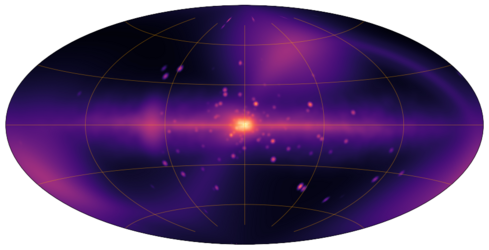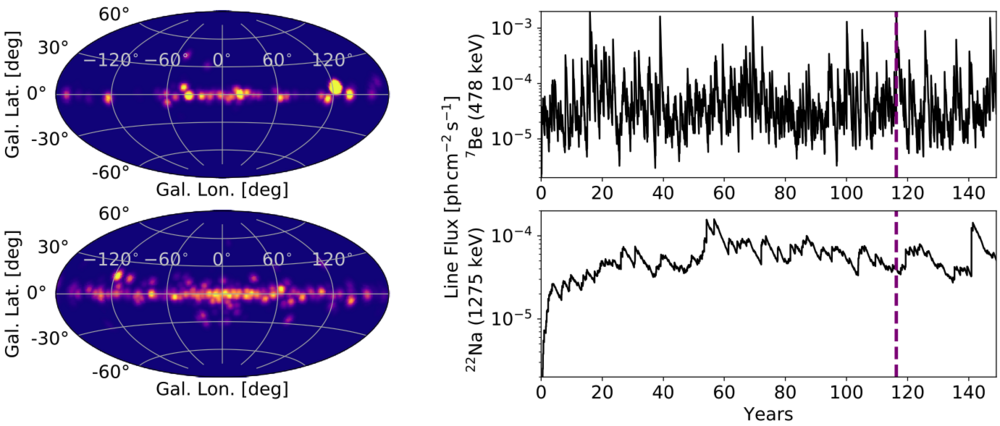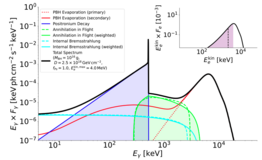AG Siegert
Nuclear Astrophysics and MeV Astronomy
Dr. Thomas Siegert
About our group
Our research group is working on high-energy astrophysics phenomena, including supernovae, novae, accreting binary systems, stellar flares, cosmic rays, and dark matter. We use MeV gamma-ray observations as the link between the thermal and non-thermal emission mechanisms, and in particular gamma-ray lines to obtain kinematics and energetics of the relevant processes. In this way, we 'X-ray' the astrophysical objects with gamma-rays and probe otherwise intangible regions.
The questions we try to address are:
- Where does the antimatter in the Milky Way in the form of positrons come from?
- What is the nucleosynthetic feedback of massive stars, novae, and supernovae in the Galaxy?
- What are the emission mechanisms that lead to the soft gamma-ray continuum?
- How do mildly relativistic leptons propagate in the interstellar medium?
- How can we indirectly measure dark matter decay, annihilation, or evaporation products?
- Are there better concepts for MeV gamma-ray telescopes?
Collaborations
We are involved with the COSI collaboration, and responsible for developing the high-level data analysis tools, COSIpy. COSI is the Compton Spectrometer and Imager, a soft gamma-ray telescope in the range between 0.2–5 MeV. It will fly in 2027 as a NASA Small Explorer (SMEX) mission for two years.
With our colleagues at the Max-Planck-Institute for extraterrestrial Physics in Garching bei München, we are collaborating to improve data analysis efforts for the coded-mask spectrometer telescope SPI aboard ESA's INTEGRAL satellite. We are maintaining a background parameter and photo-peak response database on top of the standard data processing from the INTEGRAL Science Data Center in Geneva.
Science Projects
What is the origin of positrons in the Milky Way?
This question remains unanswered after more than 50 years. The reasons why it is unanswered are versatile as instrument resolution and sensitivity only allow rough imaging of where positrons annihilate, and spectral analyses provide information of how they annihilate (charge exchange with hydrogen to form Positronium). Another complication is that there are too many possible explanations, which all potentially contribute to the total budget of positrons in the Galaxy:
- Massive stars and supernovae:
Beta-plus decay of radioactive isotopes produced in these objects and ejected into the interstellar medium. - Pulsars and microquasars:
It is inevitable for compact objects not to produce electron-positron pairs in typical conditions of high temperatures, strong magnetic fields and extreme photon densities. - Flaring stars:
Taking the Sun as an example, we know that solar flares lead to the acceleration of particles, with subsequent particle production, and fast positron annihilation. - Cosmic rays:
Secondary production of cosmic rays with interstellar gas leads to pions, which lead to positrons. - Dark matter:
Most dark matter particle models predict electrons and positrons as decay or annihilation products with some branching ratio.
While this Positron Puzzle is interesting in itself, we want to create a new astrophysical messenger of the 511 keV line. Because every source can indeed produce positrons and annihilate them, the 511 keV line may serve as an independent tool for high-energy astrophysics research. Especially with the new COSI mission, we want to understand the in-situ annihilation of positrons inside sources before escaping and propagating in the interstellar medium.
How are massive stars, novae, and supernovae enriching the interstellar medium with new elements?
We tackle this question by determining abundances and kinematics of elements through gamma-ray observations of radioactive decay lines. This has the advantage that we can estimate absolute amounts and do not have to rely on relative measurements. We aim at measuring the nucleosynthesis yields of:
- Al-26 (1809 keV) and Fe-60 (1173 & 1332 keV) from massive stars and their core-collapse supernovae:
The nuclear physics that determines the production (and destruction) of these elements during the burning phases can be calibrated by measuring their decay lines. Because the isotopes have lifetimes on the order of millions of years, whereas the supernovae rate is only about two per century, tens of thousands of objects contribute to the total diffuse signal. Because Fe-60 is only produced in supernovae, whereas Al-26 also originates from winds (and possibly novae), estimating the yields of both on the Galactic scale, on the scale of individual massive stars groups, and in the future with COSI for single stars allows us to trace back the importance of specific nuclear reactions. - Ti-44 (68, 78 & 1157 keV) from core-collapse and type Ia supernovae:
In the same manner as for Al-26 and Fe-60, we can determine the yields for Ti-44. But because the isotope has a lifetime of only 80 years, its emission is probing the cores of young supernova remnants up to several hundreds of years. With line spectroscopy in addition to the ejecta mass, we can determine asymmetries in the explosion which might in addition provide insights about the progenitors of the remnants. - Ni-56 (158 & 812 keV), Co-56 (847 & 1238 keV), and V-48 (983 & 1312 keV) from type Ia supernovae:
Thermonuclear supernovae mainly produce Ni-56 which decays to Co-56, which itself decays to stable Fe-56. The lifetimes of these isotopes are even shorter (8 and 111 days), so that they reflect the kinematics of the supernova during the explosion. Type Ia supernovae are used as 'standardisable candles' for distance estimates in cosmology. This is based on the assumption that most explosions behave in the same way and produce a similar amount of Ni-56. With gamma-ray observations, we can directly measure this ejected mass and calibrate these distance relations. Taking V-48 into account with future instruments, we will be able to distinguish different progenitor scenarios. - Na-22 (1275 keV) and Be-7 (478 keV) from novae:
Novae have never been detected in the light of soft gamma-rays. Similar to the case of Al-26, the nova rate in the Milky Way (one in two weeks) is much higher than the decay rate of Na-22 (3.75 years) and Be-7 (77 days). This means one would expect point-like emission from individual objects as well as diffuse emission from their cumulative effects. For current instruments, the yields are probably too small to be detectable, but this will change with the COSI satellite. Novae are believed to be the major producers of Lithium in the Galaxy. This can be validated through absolute yield measurements from decaying Be-7.
How are cosmic rays produced, transported, interacting, and annihilating?
Cosmic-ray electrons and positrons of GeV energies are responsible for the Inverse Compton emission in the few keV to tens of MeV range which appears as a diffuse glow in the Milky Way. Their particle spectra are measured at Earth for energies above the GeV scale, so that a prediction for the gamma-ray emission can be made. However, the predictions do not match the measurements. This may be explained by:
- Changed cosmic-ray propagation for low-energy leptons:
How electrons and positrons below GeV energies propagate is not known. It may be diffusive or advective, collisional or collisionless, or even ballistic in certain regions. The magnetic fields determine the Gyro-radius of a particle's motion, which in turn determines the scale of where and how energy losses and gains are governed. With propagation codes like GALPROP, we want to determine how leptons are propagating to produce the Inverse Compton and the positron annihilation emission. - The spectrum of cosmic rays might vary across the Milky Way:
Direct measurements of cosmic-rays are only possible close to the Solar System with the Voyager probes. For other regions, we have to rely on indirect observations. One possibility is to search for cosmic-ray-induced nuclear excitation, followed by de-excitation with the emission of characteristic gamma-ray photons. This will not only probe the spectrum of cosmic-ray protons, but also show the elemental abundance pattern. - There is a population of unidentified sources in the MeV range:
The emission mechanisms of astrophysical sources beyond hard X-rays and below GeV gamma-rays are not fully understood. A population of unresolved point sources could mimic diffusion emission in the MeV band. With newer and deeper measurements with COSI, we can possibly identify if such a contribution exists.

The interaction of cosmic rays with with interstellar gas is known to produce bremsstrahlung, nuclear excitation, and secondary particles, such as pions, which decay to emit photons (and electrons/positrons and neutrinos). If this interaction happens on solid bodies, such as asteroids or the surface of the Moon, the secondary particles may annihilate quickly, resulting in a strong 511 keV line. This leads to a time-variable foreground of keV–GeV emission from the Solar System along the ecliptic, especially from:
- Main Belt Asteroids:
Torus-like shape between Mars and Jupiter. - Jovian trojans:
Accumulation of asteroids at Lagrange points of the Sun-Jupiter-system (animation above). - Neptunian trojans:
Same as for Jupiter but numbers much more uncertain. - Kuiper belt:
Accumulation of asteroids beyond Neptune. - Oort Cloud:
Unproven but expectedly spherical accumulation of asteroids between 103–105 AU. Would appear isotropically.
Click here for our first COSI Würzburg Dark Matter workshop: Link to page
What is dark matter?
To try to answer this question, we are following the path of indirect detection, i.e. measuring electromagnetic signatures that can otherwise not be explained. Because the 511 keV emission in the Milky Way appears reminiscent of a dark matter halo profile, the conjecture was made that positron annihilation may be a direct tracer of dark matter particle annihilation or decay. In fact, also primordial black holes could produce electron and positrons through them evaporating via the yet unproven Hawking-radiation.
WIMPs in the GeV to TeV mass range would also produce electrons and positrons, in addition to their prompt emission, which propagate as cosmic rays through the Galaxy. Because their starting points may be different than those from sources in the Galactic disk, the secondary emission (Inverse Compton scattering and synchrotron emission) might appear halo-like. The final annihilation of positrons (tertiary component) might also have an imprint of the initial distribution. We are therefore searching for:
- Diffuse emission from particle dark matter in the Milky Way:
This includes prompt emission (dark matter particles to photons directly), internal bremsstrahlung, propagation signatures, positron annihilation in flight and at rest. - Diffuse emission from primordial black hole dark matter in the Milky Way:
Same as above, plus the cumulative effect of Hawking radiation from the population of low-mass black holes. - Spectral analysis of nearby galaxies:
Same as above without spatial modelling and propagation concerns. - Spatial and spectral modelling of the Andromeda galaxy:
Special case of most nearby grand spiral to model complete halo emission.







